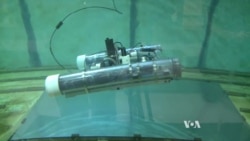Many educators believe that hands-on experience is the best way to learn.
A project developed by a group of students at the Stevens Institute of Technology, in Hoboken, New Jersey is proving that method works. The group took on a challenge posted by the U.S. Department of Defense and successfully designed and built an underwater robot for locating submerged unexploded ordnance.
In the 95-meter-long marine research tank at Stevens Institute of Technology, a group of students are able to test their underwater vehicle called Perseus II.
Remotely guided by a computer game controller, the robot dives and gracefully swims back and forth exploring the tank’s bottom with its high-definition video cameras.
Over the course of two semesters, five undergraduate students majoring in different engineering areas combined their talents, working between 15 and 20 hours a week, to design and build Perseus II.
Project supervisor, Research Associate Michael DeLorne, says the technical requirements were challenging.
“Their goal was to go down and find this unexploded ordnance and not only just find them but provide information to an expert on the surface so he or she could make a decision whether it was something dangerous or not," he said.
DeLorne says the students came up with some ingenious solutions for complicated problems, such as underwater vehicle positioning.
"One unique thing they did, they developed an algorithm that allowed them to autonomously control the vehicle's depth," he said.
Team member Mark Siembab, now a graduate student, says they also came up with an inexpensive way to mark the location of whatever object they found.
“One component sank to the bottom and anchored itself while the other component had a brightly-colored orange ball which would float to the surface and provide a positive identification to the passerby or the authorities to let them know there's an object down there and we'd marked it," he said.
Perseus II was successfully tested at a naval facility in Florida, together with similar robots built at other engineering schools. In the meantime, new students at the Stevens Institute of Technology have already started on the next project, an unmanned aerial vehicle called Perseus III.






